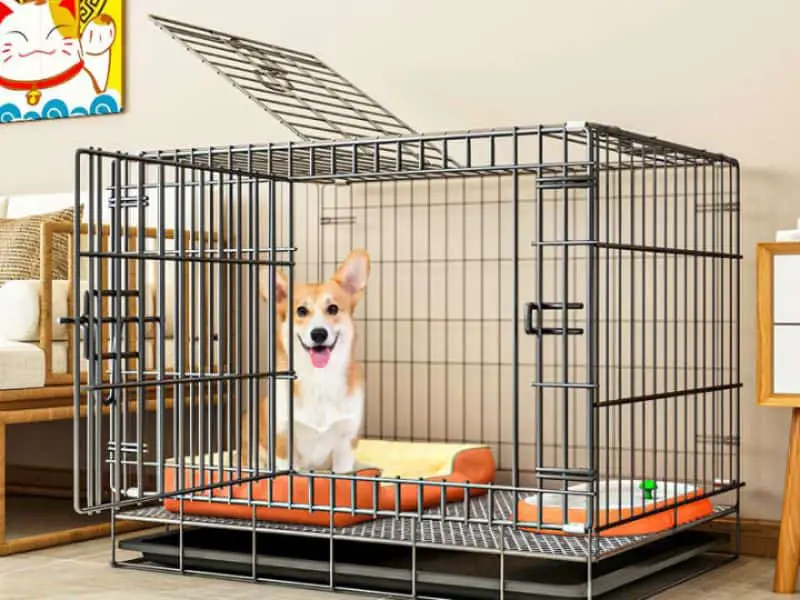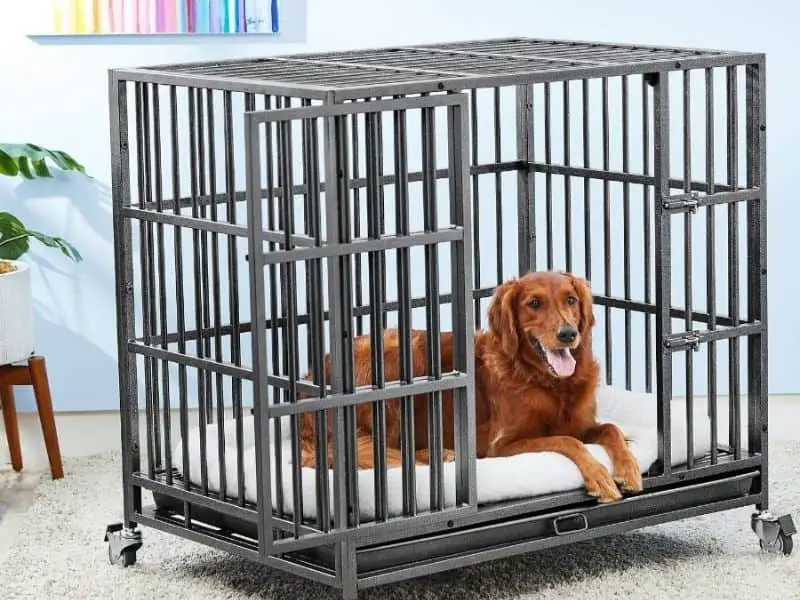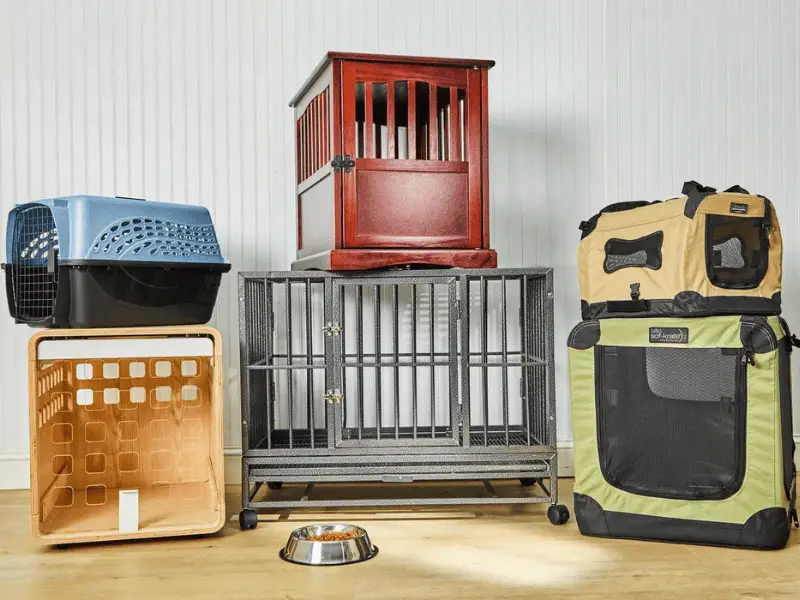Using a dog kennel size chart in choosing the right size crate for your dog is crucial for their comfort and safety.

Let’s explore the importance of selecting the appropriate size crate and how it provides a secure and comforting space for your furry friend.
By understanding the purpose behind dog crates and the significance of size, you can ensure a positive and secure environment that meets your dog’s needs.
Importance of choosing the right size crate for dogs
The importance of selecting the correct size crate for dogs can’t be overstated: it’s essential for their safety and comfort. A dog crate can supply a secure environment and promote good behavior while preventing accidents and injuries.
Here are some key points to consider:
- Comfort: Make sure your pup has enough room to stand, sit, lie down, and turn around in the crate.
- Behavior: Restricting movement helps avoid destructive behaviors when unsupervised.
- Accidents: An appropriately sized crate minimizes mess.
- Transportation: The right-sized crate ensures safety when traveling.
- Innate Need: Dogs need a den-like environment, and an appropriately sized crate can provide one.
When picking the right size, measure both length and height. Also, consider expected growth and behavior patterns. Get advice from experts or consult a dog kennel size chart for optimal results!
Purpose of dog crates in providing a safe and secure space
Dog crates are essential! They give dogs their private area. This helps dogs feel comforted and secure. It also stops them from destroying things or hurting themselves.
The purpose of dog crates is to keep dogs physically and emotionally safe.
Understanding the Dog Kennel Size Chart
When it comes to understanding the dog kennel size chart, there are a few key factors to consider, various methods for measuring your dog and different types of dog crates to choose from.
Let’s dive into each of these aspects to ensure you provide a safe and secure space for your furry friend.
Factors to Consider when Choosing a Dog Crate
When selecting a dog crate, there are a few things to keep in mind. Safety is a priority for different uses, such as training, travel, and providing a safe space.
Size matters too! It needs to be neither too small nor too large. Too small? Uncomfortable. Too large? No security. Balance is key.
Measuring is essential; length from nose to tail and height from floor to shoulder. Plus, if they’re still growing, factor that in. Breeds may need extra space too, like brachycephalic breeds due to their facial structure.
The placement of the crate is an important safety consideration. Ventilation, no direct sunlight, and securely fastening it to prevent tipping/shifting.
These factors help you make an informed decision. Consider safety and individual needs to create a comfortable and secure space. Remember, measure twice and crate once—key to the perfect fit!
Methods for Measuring Your Dog
Accurately measuring your pup is key to picking the right crate size – too small, and your pooch will be cranky. Here’s what to consider when selecting the perfect home for your four-legged friend:
- Measure your pup from nose to tail.
- Measure from the ground to top of their head/ears (depending on breed).
- Take into account expected growth and breed characteristics.
- Consider muzzle length – will they be able to comfortably stand, turn and lie in the crate?
- Make sure the space allows for movement.
- Consult a vet or pro trainer for guidance.
By following these methods, you’ll provide your pup with a safe and comfy crate!
Different Types of Dog Crates
Dog crates come in various types, each with distinct features and benefits. A helpful table outlines the types, characteristics, and intended uses. These include: wire, furniture-style, soft-sided, plastic, and travel crates.

- Wire crates offer versatility and visibility.
- Furniture-style crates blend into home decor.
- Soft-sided crates are portable and lightweight.
- Plastic crates are durable and easy to clean.
- Travel crates are designed for flying with dogs in the cabin.
When picking a crate, consider factors like functionality, ease of use, durability, and aesthetic appeal. This will ensure that your dog has a safe and comfortable space that meets its needs. Having knowledge about the different types of dog crates will empower you to select the right one.
Selecting the Right Crate Size for Your Dog
When selecting the perfect crate size for your dog, there are a few key factors to consider. In this section, we’ll dive into the details of the dog crate size chart, providing you with a step-by-step guide to finding the ideal crate size for your furry friend.
By understanding the factors that play a role in choosing a crate, you’ll ensure your dog is comfortable, safe, and secure.
Understanding the Dog Crate Size Chart
The Dog Crate Size Chart is a must-have! It can help you select the perfect size of crate for your pup. It looks at safety, expected growth, and breed characteristics.
There are various types of crates – wire, furniture-style, soft-sided, and travel. The Dog Crate Size Chart allows you to make an informed decision and provide your pup a safe and comfy space.
To understand the chart better, it’s helpful to visualize it in table form. It includes columns like safety considerations, measuring your dog, and types of crates. There are wire crates for general use, furniture-style for home decor, soft-sided for portability, plastic for durability, and travel for flying.
Plus, there are more details to consider – safety when placing the crate, benefits, and features of materials and styles.
Considering these will help you make the best decision for your pup. So, remember to remember these points next time you refer to the Dog Crate Size Chart!
Step-by-Step Guide for Finding the Perfect Crate Size
Weigh your dog accurately using a pet scale to get the perfect crate size for your pup! Then measure their length from the tip of their nose to the base of their tail. This should be a straight line no curves.
When standing up, measure their height from the floor to the top of their head or ears. Take into account expected growth if they are a puppy or young dog.

Larger breeds may require more space, while smaller breeds need less. Consider breed characteristics and behavior.
Some dogs prefer enclosed spaces; others like more room. Lastly, think about where the crate will be located. Make sure it’s safe and secure!
Understand the benefits and features of different materials and styles of crates to select one that fits your and your pup’s needs.
Finding the right crate is finding the balance between comfort and prison chic. Follow this guide to make an informed decision and choose the right size for your furry friend!
Factors to Consider in Choosing a Crate
Selecting the right crate for your dog requires careful thought. This is to ensure your pup’s safety and comfort while in the crate. Consider these points when making your decision:
- Safety: Pick a crate that can be firmly secured in your house or car. Proper ventilation and stability are essential to prevent mishaps.
- Size: The crate should be the right size for your dog’s comfort and behavior. Too small makes them feel cramped, while too large may not offer the security they need.
- Materials and styles: Choose from wire, furniture-style, soft-sided, plastic, or travel crates. Each has its own benefits and features.
Prioritize safety, comfort, and needs, then select a crate that provides your pup a safe and secure space.
Enhancing the Crate Experience
Enhance your crate experience with crate accessories that provide comfort and convenience. Discover additional resources and references to optimize your dog’s kennel size further using our comprehensive dog kennel size chart.
Crate Accessories for Comfort and Convenience
Crate accessories are vital for providing dogs with comfort and ease in their crates. They are designed to improve the crate experience, ensuring dogs feel safe, calm and content.
- Crate Covers: These give pups privacy and create a den-like atmosphere. They can reduce anxiety by blocking out external stimuli, giving dogs a secure area to hide.
- Trays: Crate trays make cleaning easier. They protect the bottom from spills, helping you keep it clean.
- Panels/Dividers: Perfect for crate training puppies. They let you adjust the size as your pup grows, giving them enough space.
- Casters: Attach wheels to crates, making them effortless to move around. Great if you need to transport or reposition the crate often.
- Toys: Toys provide mental stimulation, reduce boredom and give dogs a sense of comfort. Choose the right ones to keep your pup entertained while they’re inside.
These accessories help dogs feel comfortable. Adding comfort features and practical considerations like trays and dividers creates the ideal environment for both physical and psychological needs.
It’s important to pick the right accessories for your pup. Every dog is different, so select accessories that meet their needs. By providing the right accessories, owners can improve their dog’s crate experience and create a space of comfort, relaxation, and safety.
Additional Resources and References
Explore more knowledge through online forums, dog training websites, pet supply stores, and books from reputable authors with canine behavior expertise.

Gain valuable information from these sources, including discussions, articles, FAQs, guides, tutorials, tips, product specs, customer reviews, buying guides, videos, and explanations with examples.
Use these references to understand crate training better and make well-informed decisions on the best size for your pet. Get insights and experiences from fellow dog owners and experts – invaluable for creating a positive crate experience for your pup.
Final thoughts on the dog kennel size chart
To sum up, getting the perfect kennel size for your pup is key for their well-being and safety. The dog kennel size chart is a great reference to go by.
It has recommended sizes based on different breeds and weights. Just look at it, and you can ensure your pet has enough room to feel comfortable and secure.
Plus, there are extra things you can do to help your pup. For comfort, give them soft bedding and padding like blankets, cushions, and foam mats.
Also, put their kennel in a quiet spot in your house to make them feel relaxed. Cleaning and maintaining it is important, too, to maintain hygiene and avoid any health issues.
Following these tips and taking into account the information from this article will ensure your pup is safe and content. Making sure you get the right kennel size, keeping their needs in mind, and taking extra steps for their comfort and hygiene will all contribute to their well-being.
Safe and Secure: Understanding the Dog Kennel Size Chart
- Dogs should have a crate that allows them to stand up, turn around, and lie down comfortably.
- The correct crate size is determined by measuring the dog’s length from nose to tail and adding 4 inches.
- Different types of crates are available, including wire, furniture-style, soft-sided, plastic, and travel crates.
- Crates serve multiple purposes, including house training, behavioral training, travel, rest, and providing a private hideaway.
- It is crucial to choose the right crate size to ensure the dog’s comfort, safety, and positive crate training experience.



Leave a Reply